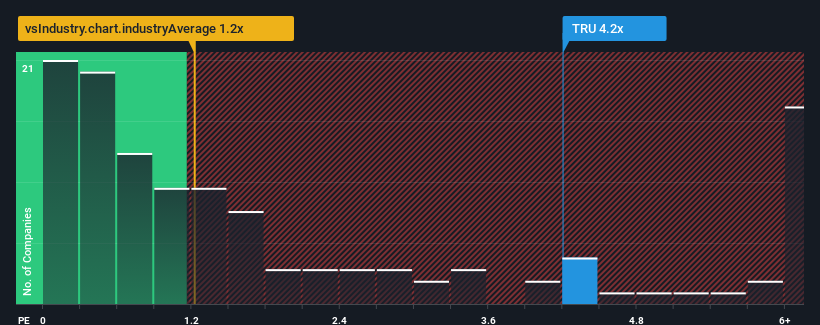- United States
- /
- Professional Services
- /
- NYSE:TRU
TransUnion's (NYSE:TRU) 27% Share Price Surge Not Quite Adding Up
Those holding TransUnion (NYSE:TRU) shares would be relieved that the share price has rebounded 27% in the last thirty days, but it needs to keep going to repair the recent damage it has caused to investor portfolios. Looking further back, the 17% rise over the last twelve months isn't too bad notwithstanding the strength over the last 30 days.
Following the firm bounce in price, you could be forgiven for thinking TransUnion is a stock to steer clear of with a price-to-sales ratios (or "P/S") of 4.2x, considering almost half the companies in the United States' Professional Services industry have P/S ratios below 1.2x. Although, it's not wise to just take the P/S at face value as there may be an explanation why it's so lofty.
We've discovered 2 warning signs about TransUnion. View them for free.Check out our latest analysis for TransUnion

What Does TransUnion's Recent Performance Look Like?
TransUnion's revenue growth of late has been pretty similar to most other companies. Perhaps the market is expecting future revenue performance to improve, justifying the currently elevated P/S. However, if this isn't the case, investors might get caught out paying too much for the stock.
Keen to find out how analysts think TransUnion's future stacks up against the industry? In that case, our free report is a great place to start.Is There Enough Revenue Growth Forecasted For TransUnion?
There's an inherent assumption that a company should far outperform the industry for P/S ratios like TransUnion's to be considered reasonable.
Taking a look back first, we see that the company managed to grow revenues by a handy 8.8% last year. This was backed up an excellent period prior to see revenue up by 34% in total over the last three years. Therefore, it's fair to say the revenue growth recently has been superb for the company.
Shifting to the future, estimates from the analysts covering the company suggest revenue should grow by 7.8% per year over the next three years. Meanwhile, the rest of the industry is forecast to expand by 6.9% each year, which is not materially different.
In light of this, it's curious that TransUnion's P/S sits above the majority of other companies. Apparently many investors in the company are more bullish than analysts indicate and aren't willing to let go of their stock right now. Although, additional gains will be difficult to achieve as this level of revenue growth is likely to weigh down the share price eventually.
The Key Takeaway
TransUnion's P/S has grown nicely over the last month thanks to a handy boost in the share price. We'd say the price-to-sales ratio's power isn't primarily as a valuation instrument but rather to gauge current investor sentiment and future expectations.
Analysts are forecasting TransUnion's revenues to only grow on par with the rest of the industry, which has lead to the high P/S ratio being unexpected. When we see revenue growth that just matches the industry, we don't expect elevates P/S figures to remain inflated for the long-term. This places shareholders' investments at risk and potential investors in danger of paying an unnecessary premium.
And what about other risks? Every company has them, and we've spotted 2 warning signs for TransUnion (of which 1 is potentially serious!) you should know about.
If strong companies turning a profit tickle your fancy, then you'll want to check out this free list of interesting companies that trade on a low P/E (but have proven they can grow earnings).
Valuation is complex, but we're here to simplify it.
Discover if TransUnion might be undervalued or overvalued with our detailed analysis, featuring fair value estimates, potential risks, dividends, insider trades, and its financial condition.
Access Free AnalysisHave feedback on this article? Concerned about the content? Get in touch with us directly. Alternatively, email editorial-team (at) simplywallst.com.
This article by Simply Wall St is general in nature. We provide commentary based on historical data and analyst forecasts only using an unbiased methodology and our articles are not intended to be financial advice. It does not constitute a recommendation to buy or sell any stock, and does not take account of your objectives, or your financial situation. We aim to bring you long-term focused analysis driven by fundamental data. Note that our analysis may not factor in the latest price-sensitive company announcements or qualitative material. Simply Wall St has no position in any stocks mentioned.
About NYSE:TRU
TransUnion
Operates as a global consumer credit reporting agency that provides risk and information solutions.
Fair value with moderate growth potential.
Similar Companies
Market Insights
Community Narratives





